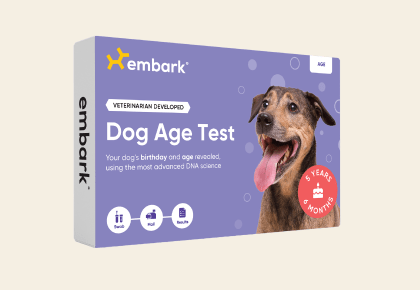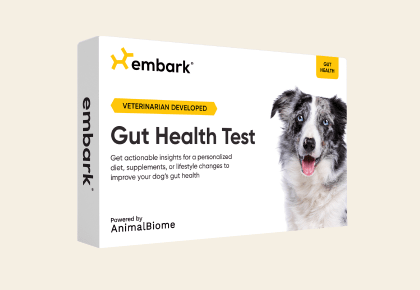Disclosure: This article contains affiliate links, meaning that Embark may receive a small commission if you make a purchase. All linked products have been reviewed by a veterinarian.
When’s the last time you brushed your dog’s teeth? While February is National Pet Dental Health Month, good oral hygiene is important all year round. Brushing your dog’s teeth at home is a good way to maintain their dental health and help prevent disease.
Learn all about your dog’s dental health, how to brush your dog’s teeth at home, and when it’s time to see a professional.
Why it’s important to brush your dog’s teeth
Brushing your dog’s teeth helps prevent plaque buildup. “Without regular brushing, dental plaque can turn into tartar, leading to periodontal disease,” says Jenna Dockweiler, MS, DVM, DACT, CCRT, CVAT, a veterinarian and veterinary geneticist at Embark.
Periodontal disease is the most common dental condition in dogs, according to the American Veterinary Medical Association (AVMA). Some studies estimate that up to 80% of dogs have a form of gum disease by age 3. Periodontal disease not only affects your dog’s mouth, but can lead to heart, kidney, or liver disease as well. An individualized periodontal disease prevention and treatment plan should be part of your dog’s lifetime oral health.
In addition to regular veterinary care, brushing your dog’s teeth at home is a simple step you can take to help prevent this type of disease. Learn more about the importance of dental care throughout a dog’s life.
How often should you brush your dog’s teeth?
It’s recommended that you brush your dog’s teeth daily. Set a reminder in your phone to brush your dog’s teeth every day. Make brushing part of your morning routine, perhaps before or after you brush your own teeth.
What to use when brushing your dog’s teeth
To get started, you’ll need a toothbrush (or finger brush) and dog-safe toothpaste.
“A finger brush is great for puppies and dogs who aren’t yet accustomed to a regular canine toothbrush,” says Dr. Dockweiler.
Whether you choose a finger brush or a regular toothbrush, make sure that any products you use to brush your dog’s teeth are accepted by the Veterinary Oral Health Council (VOHC). For example:
- Petsmile Professional Dog Toothpaste
- An ADA-compliant soft-bristle, flat head toothbrush, like the CET Dual End Toothbrush
Giving your dog a daily dental chew can also help to remove some of the plaque on their teeth and gums. Using dental chews can help augment teeth brushing, but shouldn’t replace it.
“These treats physically remove tartar from your dog’s teeth by scrubbing as they chew,” says Dr. Dockweiler. “Be sure to supervise your dog with any chew, as large pieces can become a choking hazard. And don’t forget that treats and chews count towards your dog’s total daily calorie intake!”
Chews like Greenies® Dental Dog Treats, Milk-Bone Brushing Chews, and Checkups Dental Dog Treats are accepted by VOHC and popular with many pet owners.
Chances are that your dog will love a treat, making it easy to check this off their daily dental care list.
How to brush your dog’s teeth
A regular teeth brushing routine is an important part of maintaining your dog’s dental health.
To help your dog get used to the brush, Dr. Dockweiler recommends first applying some flavored, dog-safe toothpaste to the brush and letting your dog lick it off. Gradually add in brushing motions, starting with the canines and front teeth.
“Be sure to keep it positive by giving your dog lots of praise throughout the process,” Dr. Dockweiler advises. “Ultimately, your dog should allow you to brush all their teeth and even look forward to this bonding time.”
Here is a step-by-step guide to brushing your dog’s teeth:
- First, make sure you have dog toothpaste and either a toothbrush for dogs or a fingertip toothbrush. Let your dog taste the toothpaste so they know it’s delicious and not something to fear.
- Angle the bristles of the brush up along the gum line. Work from the back of the mouth to the front, making small circles along your dog’s gum lines on the upper teeth.
- If your dog lets you keep going, work from the back to the front along the bottom jaw.
- Your dog might not let you brush many teeth the first time or the first few times. That’s okay, you’re making progress and taking steps towards prevention.
- Praise your dog afterward and spend some quality time together so they associate teeth brushing with positive reinforcement.
If you and your dog are new to the process, start slowly and practice patience. Soon enough, your dog will get used to the process and you’ll establish a regular teeth brushing habit.
Can you brush a dog’s teeth with human toothpaste?
No. Toothpaste made for humans contains ingredients that aren’t safe for dogs, such as fluoride and xylitol. If swallowed, these ingredients are toxic to dogs. VOHC-accepted toothpaste for dogs is a safer alternative and comes in dog-friendly flavors, like chicken and peanut butter.
Signs of dental disease in dogs
According to the AVMA, some signs of periodontal disease include:
- Bad breath
- Broken or loose teeth
- Extra teeth or retained baby teeth
- Teeth that are discolored or covered in tartar
- Abnormal chewing, drooling, or dropping food from the mouth
- Reduced appetite or refusal to eat
- Pain in or around the mouth
- Bleeding from the mouth
- Swelling in the areas surrounding the mouth
Sometimes, dental problems might cause a dog to become irritable or sensitive to touch near their mouth or face. If you notice any of the above signs, or a change in your dog’s behavior, make an appointment with your veterinarian.
When to take your dog to a veterinarian
It’s generally recommended to take your dog to the veterinarian for teeth cleaning about once a year after they’re six months old. Regular veterinary check-ups usually include a dental evaluation. Use that time to talk to your vet about your at-home oral hygiene routine and the recommended frequency of dental cleanings.
When you take your dog for a professional teeth cleaning, know that they’ll be put under general anesthesia and get X-rays. That’s so that the veterinarian can do a thorough job of removing tartar and plaque and polishing their teeth.
Now is a great time to start a regular brushing habit and take care of your dog’s teeth. You’ll be doing your part to keep them as safe and healthy as possible with this preventative care habit.
Continue learning all about dog teeth with this explanation of the various stages of puppy teeth and adult teeth.











